
Recent years have seen a decline in the number of students enrolled in second-cycle programmes in Poland. This has resulted in higher education institutions expressing concerns and citing themselves as responsible for the decreasing popularity of such programmes, which have become less attractive than other alternatives, such as the commencement of a professional career. The lower number of candidates is also attributable to demographic changes, including Poland’s persistently low fertility rate.
In autumn 2023, ELA expanded its analyses by introducing new data that describes the processes of transitioning between first- and second-cycle programmes. This has enabled graduates to access comprehensive insights into their education pathways. In the future, the new module will be developed further to assist higher education institutions in assessing and adapting their strategies to the evolving environment.
The decrease in students who commenced second-cycle programmes is substantiated by reliable data. Between 2015 and 2021, their number reduced by nearly 30,000, a continuous decline that initiated in 2017 (see Figure 1).
Figure 1. The numbers of students who commenced second-cycle programmes
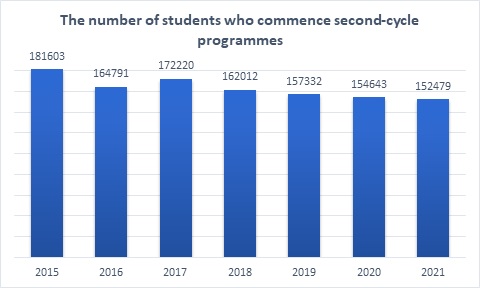
Did first-cycle graduates pursue second-cycle programmes immediately after graduation?
Figure 2 illustrates that approximately two-thirds of graduates pursued second-cycle programmes immediately after completion of their first-cycle degrees. In the years after graduation, the percentage of first-cycle graduates who enrolled in second-cycle programmes was negligible and diminished in each consecutive year. Fewer than 1% of graduates pursued second-cycle programmes five years after graduation. This was observed among all first-cycle graduate cohorts monitored by ELA.
The data demonstrated clearly that the proportion of students who continued second-cycle programmes relative to the total number of graduates remained stable during the monitoring period. Approximately 70% of first-cycle graduates continued their educations in second-cycle programmes. This suggests that the decrease in the number of candidates can be attributed to demographic factors rather than changes in the behaviour patterns of graduates.
Figure 2. How long after their first-cycle programmes graduates enrolled in second-cycle programmes
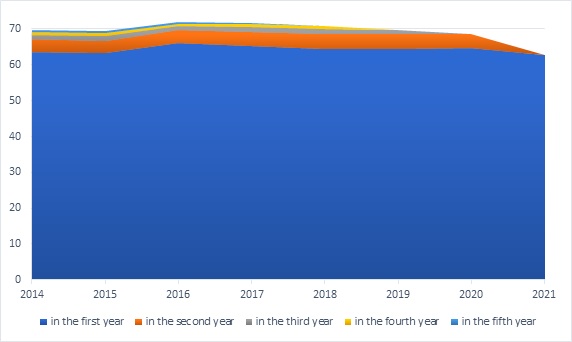
In light of the substantial majority of graduates who embark on second-cycle programmes in the first year after the completion of their first-cycle programmes, the remainder of our analysis will be directed towards this pivotal year.
Although the overall percentage of first-cycle graduates who continued their educations remained stable, differences were observed between particular domains of study (see Figure 3).
Figure 3. The percentage of students who graduated between 2014 and 2021 and continued their educations in the first year after the completion of their first-cycle degrees by domain of study
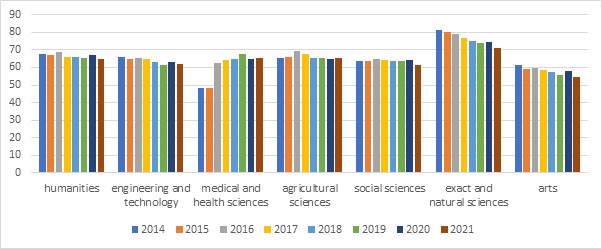
Upon examination of Figure 3, two observations become evident. First, graduates of exact and natural sciences exhibited the keenest interest in pursuing second-cycle programmes—although this effect became less visible with each subsequent cohort.
Second, 2016 witnessed an unprecedented rise in the number of first-cycle graduates of medical and health sciences who opted for second cycle programmes. According to ELA data, that surge was driven chiefly by the decisions of nursing and midwifery graduates (see Figure 4).
Figure 4. The percentages of medical and health sciences graduates who continued their educations in the first year after the completion of their first-cycle degrees between 2014 and 2021
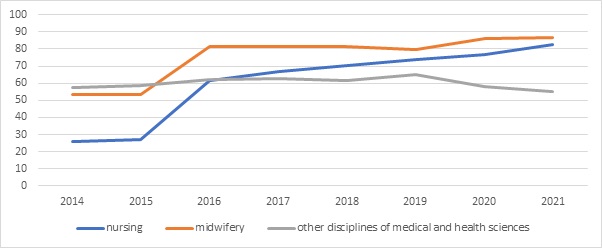
To better understand the motivations of nurses and midwifes, we must note that before 2016, the salaries of first-cycle graduates in those fields were comparable to those of second-cycle graduates; in 2016, however, the differences in salaries between the two groups became more pronounced. This coincided with the implementation of new regulations that permitted second-cycle nursing and midwifery graduates to write prescriptions. Figure 5 presents nurses' and midwives' salaries in consecutive years expressed as values of the relative earnings rate, which enables accurate year-to-year salary comparisons. The final year in which salaries were similar was 2015, regardless of the degrees nurses and midwives held. Larger salaries for second-cycle graduates unquestionably contributed to the increased popularity of such programmes among this group (see Figure 5).
Figure 5. Relative earnings rates in the first year after the completion of the first- and second-cycle nursing and midwifery programmes between 2014 and 2021
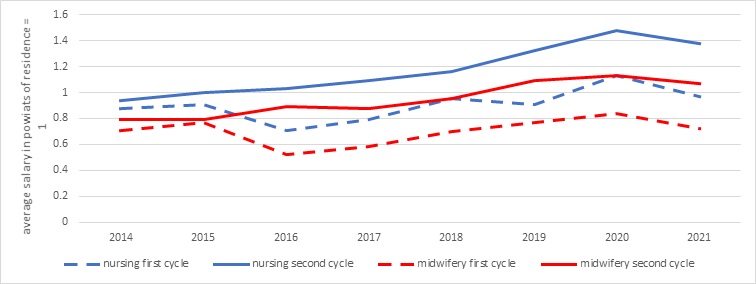
The role of alma maters
It was also worth exploring whether graduates continued their educations at the same higher education institutions at which they completed their first-cycle programmes. ELA provided information on the percentages of first-cycle graduates who opted to pursue their second-cycle programmes at the same institutions. The data measured institutions’ abilities to attract their own first-cycle graduates to their second-cycle programmes (see Figure 6).
Figure 6. The percentages of first-cycle graduates who pursued second-cycle programmes at their alma maters

The pattern appears to be similar in all consecutive years. In the first year after the completion of their first-cycle degrees, over three-quarters of graduates pursued second-cycle programmes at their alma maters. The percentage decreased in subsequent years, which indicates alma maters’ waning 'power of attraction'—a natural and expected occurrence. Institutions’ power to maintain their own first-cycle graduates also varied across domains of study (see Figure 7).
Figure 7. The percentage of first-cycle graduates who pursued second-cycle programmes at their alma maters

First-cycle graduates in medical and health sciences were the most hesitant to continue their educations at their alma maters (68% in 2021). This presents a considerable challenge for higher education institutions that specialised in that domain. Arts institutions also became less successful in persuading their graduates to enrol in their second-cycle programmes. Conversely, over 80% of graduates who majored in agricultural sciences, engineering and technology, or exact and natural sciences continued their educations at their alma maters. ELA data suggests that this effect varies across institutions. We suggest that institutions monitor their own 'power of attraction' and observe the changes in its dynamics closely.
Summary
Approximately two-thirds of first-cycle graduates continued their educations by enrolling in second-cycle programmes. Typically, decisions to pursue education further were made immediately after the completion of first-cycle degrees, which lies in contrast to the Anglo-Saxon education system, for example. Data suggests that first-cycle graduates with a major in exact and natural sciences became increasingly less interested in continuation of their studies. Conversely, in 2016 and beyond, second-cycle programmes witnessed a surge in popularity among graduates in nursing and midwifery.
The majority of graduates—particularly those who continued their educations immediately after completion of their first-cycle degrees—pursued second-cycle programmes at their respective alma maters. Nationally, the share of students who pursued second-cycle programmes at their alma maters remained constant throughout the monitoring period. Noticeable differences were recorded, however, across particular institutions and domains of study.